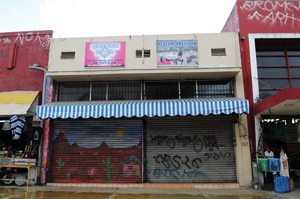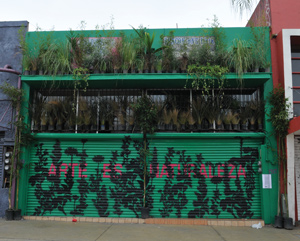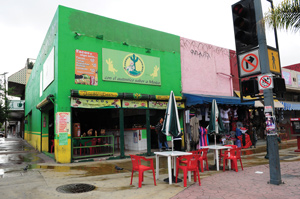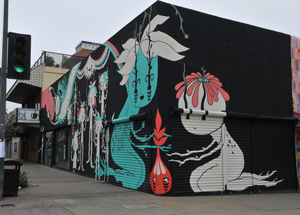Sociological art is the one that without being exhibitedunder the imposing lights of a museum or a gallery becomes part of spaces and daily life situations to influence and transform reality. This is a trend that has been gaining ground since the 1960s and continues to be a great revelation in our society. Its power lies on the capacity to act as a triggering element in the relation between the work of art and the viewer. Renewing the senses of cultural supply, sociological art uses the urban setting as a social membrane encouraging a closer look to arts within daily life dynamics by seizing transit spaces and areas for common use.
This kind of art seeks, above all, to become public and is created by artists who decide to leave museums and exhibiting spaces (places that could be regarded as exclusive; let us remember that a high number of people see museums and galleries as foreign, hostile places totally alien to them) to be part of the urban space, matching their artistic works with the architectural and social conditions making up the context. The spaces on which artists interested in generating works of sociological nature fit into are usually a challenge to them as they have to expose their work to heterogeneous contact with urban publics. Such situation generates an undeniable attitude of willingness in the inhabitants of the city, awaking in them, in a natural and unexpected manner, the pleasure to take a time to see, enjoy and consider the possibility of opening their daily lives to new horizons.
 Sociological art provokes in us not only a state of reflection as human beings –as we are beings open to generating spaces for social integration–, but boosts living standards of our cities due to its positive impact on education, image and development. Its active presence in the city can generate a community-based creative awareness requiring different competence and skills for the transformation of gray and homogeneous public urban contexts.
Sociological art provokes in us not only a state of reflection as human beings –as we are beings open to generating spaces for social integration–, but boosts living standards of our cities due to its positive impact on education, image and development. Its active presence in the city can generate a community-based creative awareness requiring different competence and skills for the transformation of gray and homogeneous public urban contexts.
Every artistic expression or intervention is born and projected in response to a cultural need. Such is the case of Revolucion Avenue, the oldest avenue of the city of Tijuana, BC (the busiest border of the world)–seed of tourist activity and the emergence of the city in the 1920s. As a result of the most recent world economic and political crisis, Revolucion Avenue has fall into a state of deep abandonment. With its vitality faded due to the drop in tourism, trade and investments, the avenue was crying out for a true intervention by artistic projects. Its forgotten present needed to be excelled by an enthusiastic transformation capable of reorienting its path and reconfiguring its purpose; the best way to achieve that goal was by making the values of its citizens visible through aesthetic and identity enhancing proposals.
Responding to the urgency of those interests, the entijuanarte rEVOLUCIONa project was carried out in the city of Tijuana at the beginning of October 2010 under the curatorship of Olga Margarita Davila, who, with creative intensity and through different artistic proposals, wanted to absorb the past from the traces left by the many stories making up Revolucion Avenue. Her slogan: revive them as an expression of a promising present.  Being this one a decisive moment to make the origins of the city transcend so it stopped being permanently entrenched as the “servant the northern neighbors,” (serving alcohol in times of prohibition; sex in times of the Vietnam and other wars). Tijuana deserves to believe in its present as a bearer of a revolutionized future. Activating the city meant sparking off a social transformation based on artistic initiatives. Cases of similar successful enterprises were seen in Latin America. Medellin and Bogota, Colombia –both showing high violence rates– are examples today of the power of cultural processes as driving forces in the reconstruction of civil confidence and social security. Another widely known case was the committed activation of artistic projects as processes for social cohesion during the integration of East and West Berlin after the fall of the Berlin Wall.
Being this one a decisive moment to make the origins of the city transcend so it stopped being permanently entrenched as the “servant the northern neighbors,” (serving alcohol in times of prohibition; sex in times of the Vietnam and other wars). Tijuana deserves to believe in its present as a bearer of a revolutionized future. Activating the city meant sparking off a social transformation based on artistic initiatives. Cases of similar successful enterprises were seen in Latin America. Medellin and Bogota, Colombia –both showing high violence rates– are examples today of the power of cultural processes as driving forces in the reconstruction of civil confidence and social security. Another widely known case was the committed activation of artistic projects as processes for social cohesion during the integration of East and West Berlin after the fall of the Berlin Wall.
entijuanarte 2010 faced the demands of the context at the moment forcing it to come out in a creative way amid a complex and critical social and urban situation. To meet the demands of a city under constant state of alert it was required to put together different expressions arising from new visual consumptions and renewed cultural patterns. entijuanarte rEVOLUCIONa tried, thus, to remove the stigma of the city so that it stop being “Tijuana –mother of all vices”–, to turn into a city recovered by its citizens through art. In 2006 the New York Times labeled Tijuana as a “Hip&Hot” city for its dynamic artistic scenario; The Timeshad already described it as a “new Mecca for Art” barely a few years earlier. Revalidating such media statements, entijuanarte 2010 set for its 6th edition the difficult task of returning to Tijuana its acknowledgment and potential to produce artists and cultural audience of high level.
entijuanarte rEVOLUCIONaannounced the artistic intervention of 22 facades of semi-abandoned buildings along Revolucion and social-anthropological one on site. The decision of making the interventions on public spaces of a declining commercial and tourist area seeks to mark the difference of use between locals and visitors and to give a boost to the vocational transition of the center of the city.
To consolidate the process of raising awareness on the artistic interventions on the Avenue, well-known national and international artists and groups from Tijuana –host city–; Zacatecas –guest state–; neighboring cities of the south of California, U.S.; Oaxaca, Monterrey, Federal District and San Luis Potosí –friend cities were summoned; also teams of architecture, visual arts and design students were called for. A total of 60 plastics arts and design specialists from UABC and CUT University participated.
 The artists and projects that made entijuanarte rEVOLUCIONa a reality were: Fidel Figueroa, Luis Carrera-Maul, La Piztola Collective, Charles Glaubitz, Pablo Llana, Foi Jimenez, Ruben Gutierrez Garza, Jesus Ramos, Helio Montiel, Alfredo Gutierrez, Vero Glezqui, Vanessa Garcia Lembo, Said Dokins, HEM Collective, Miguel Angel Iñiguez, Barbara Cruz, Luis Manuel Serrano, Elba Roadhs, Oslyn Whizar, Reacciona Tijuana, team of entijuanarte rEVOLUCIONa.
The artists and projects that made entijuanarte rEVOLUCIONa a reality were: Fidel Figueroa, Luis Carrera-Maul, La Piztola Collective, Charles Glaubitz, Pablo Llana, Foi Jimenez, Ruben Gutierrez Garza, Jesus Ramos, Helio Montiel, Alfredo Gutierrez, Vero Glezqui, Vanessa Garcia Lembo, Said Dokins, HEM Collective, Miguel Angel Iñiguez, Barbara Cruz, Luis Manuel Serrano, Elba Roadhs, Oslyn Whizar, Reacciona Tijuana, team of entijuanarte rEVOLUCIONa.
Descriptive selection of six projects
Alfredo Gutierrez / Tijuana:The proposal of this young artist consisted in giving a face to the mystical “Aunt Juana” (Tía Juana). There are many stories in the mythology around the origins of the name of Tijuana, one of them says the name of the city is a contraction of the words Tía-Juana –in reference to a dairy that existed back in the first half of the 19th century in this region of the pacific coast. In his intervention on the metallic curtain and façade of the Monte Alban Curios facility, Alfredo Gutierrez was inspired by the colors, scripts and forms of the context to offer a new “skin” to the place.
Pablo Llana / Tijuana: Tijuana-born Pablo Llana’s project deals in an ironic and humorous manner with the importance of self-care as a premise for existence and urban negotiation. Given Tijuana’s condition of being an extreme city not only geographically speaking but also as a space of radical permissibility inherited from a “black legend,” Pablo Llana retakes the figure of the evil character in the latest Batman movie as a pretext to represent the duality of the city. Extreme stimulation through excesses and vices, as well as the equanimity that should be searched through self-esteem are the two opposite sides described by the artist. This dual condition is activated as people stop by the “happy face” painted on the sidewalk with a sign that reads: “You are here,” in the right spot from where they can see the intervened curtains.
 Luis Carrera-Maul / Zacatecas:Luis Carrera-Maul’s intervention proposes a moment of calm in the busy Revolucion Avenue. Amid the noisy energy that still flood this part of the city (mixture of loud music coming from bars and shops, a set of eclectic buildings of different volumes; advertisement posters, blankets and all sorts of colorful and illuminated signs) Carrera-Maul invites us to walk into a quiet place. His message is vital, not only to the avenue in which it has a direct impact, but in general to current times of economic and social tension: “ART IS NATURE.”
Luis Carrera-Maul / Zacatecas:Luis Carrera-Maul’s intervention proposes a moment of calm in the busy Revolucion Avenue. Amid the noisy energy that still flood this part of the city (mixture of loud music coming from bars and shops, a set of eclectic buildings of different volumes; advertisement posters, blankets and all sorts of colorful and illuminated signs) Carrera-Maul invites us to walk into a quiet place. His message is vital, not only to the avenue in which it has a direct impact, but in general to current times of economic and social tension: “ART IS NATURE.”
Foi Jimenez / Tijuana:Tijuana-born Foi Jimenez’s intervention is a big mural on top of one of the facilitated located on a corner on Revolucion Avenue. The narrative proposal of his pictorial-urban intervention seeks to give rise to new myths for the city; myths can blossom from its ancient/new main street. The artist presents in his work the emergence of fantastic beings that will live in a new Tijuana: plant-beings. Jimenez presents values of nature as new principles of an incipient society as a rebirth from a troubled past.
Group La Piztola (Roberto, Rosario, Yankel) / Oaxaca:La Piztola’s proposal invites us to reflect on what needs to be “cleaned up” and reorganized in the collective environment. La Piztola encourages us to identify our icons, the emblems representing us; those elements that make us say: “This is Tijuana.” The artists say: “We are with you and we join you in your cause.” This bond was built by finding points of connection between Tijuana and Oaxaca, being music the most significant shared finding; specifically the use of the accordion. Spread across the nation, the group states that according music is the common point between peoples and regions that are apparently distant from each other.
Fidel Figueroa / Mexico City:Putting forward a comprehensive intervention of the building on the corner of Revolucion Avenue and 6th Street, Fidel Figueroa’s project is a firm idea to regenerate the avenue’s structure. By taking the trail left by cars and passersby as graphic principle and painting it in green –a color usually associated to nature and wellbeing–, the artist have all local and foreign people who have ever walked in that area involved transforming them into artistic matter. His action fully refers to the main interests of entijuanarte rEVOLUCIONa: being a bet to dignify, recover and support creativity and artistic quests as means to find new citizen paths in this avenue.
entijuanarte rEVOLUCIONa
Curator Olga Margarita Dávila
Coordination Luis Garzón Masabó, Gabriela Posada
Operation Edgar Montiel
Art Direction Cecilia Ochoa
General Direction Julio Rodríguez
Related Publications

How Harumi Yamaguchi invented the modern woman in Japan
March 16, 2022
Giovanni Duarte and an orchestra capable of everything
August 26, 2020











